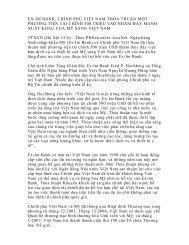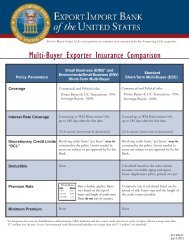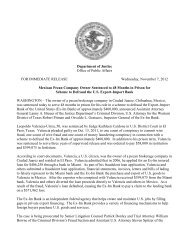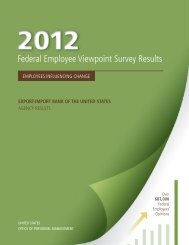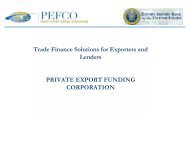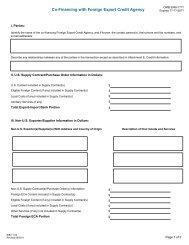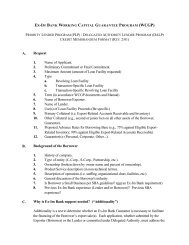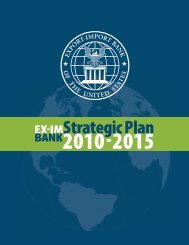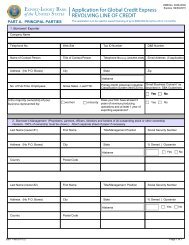2010 Competitiveness Report - Export-Import Bank of the United ...
2010 Competitiveness Report - Export-Import Bank of the United ...
2010 Competitiveness Report - Export-Import Bank of the United ...
Create successful ePaper yourself
Turn your PDF publications into a flip-book with our unique Google optimized e-Paper software.
10%, that are added to <strong>the</strong> MPR. Hence, <strong>the</strong> private buyer fee does not go higher than<br />
50% over <strong>the</strong> MPR.<br />
In <strong>2010</strong>, as <strong>the</strong> OECD-mandated implementation date <strong>of</strong> <strong>the</strong> Malzkuhn-Drysdale<br />
Package grew closer, <strong>the</strong> <strong>Bank</strong> decided to introduce <strong>the</strong> new fees for <strong>the</strong> <strong>Bank</strong>’s mediumterm<br />
program in order to test <strong>the</strong> impact and utility <strong>of</strong> <strong>the</strong> new system. While <strong>the</strong> OECD<br />
Agreement also takes an incremental approach to pricing risk, <strong>the</strong> surcharge between<br />
each risk level (CC1-CC5) is much higher than Ex-Im’s internal pricing system. This<br />
action created a temporary bifurcated pricing structure for <strong>the</strong> <strong>Bank</strong>’s medium- and<br />
long-term programs, but will enable <strong>the</strong> Ex-Im to address any internal issues with <strong>the</strong><br />
new fee system before <strong>the</strong> formal September 1, 2011 implementation date.<br />
G-7 ECAs’ Policies and Practices<br />
Like Ex-Im <strong>Bank</strong>, <strong>the</strong> G-7 ECAs generally charge <strong>the</strong> MPR for sovereign transactions.<br />
However, risk-rating methodologies, use <strong>of</strong> risk mitigants, and pricing mechanisms vary<br />
widely among <strong>the</strong> G-7 ECAs. As a result, <strong>the</strong>re is a fairly wide divergence in <strong>the</strong> fees<br />
charged by G-7 ECAs for similar non-sovereign transactions. The difference among<br />
ECAs in terms <strong>of</strong> experience, portfolios and philosophies generate this wide range in<br />
private buyer risk-rating and pricing. This was evidenced during <strong>the</strong> many years <strong>of</strong><br />
premia negotiations when different ratings for <strong>the</strong> same or similar buyers emerged.<br />
Years <strong>of</strong> risk rating and pricing exercises during <strong>the</strong> premia negotiations drew out <strong>the</strong><br />
countries that take an incremental approach to pricing non-sovereign risk and those<br />
that take a more comprehensive approach – pricing based <strong>of</strong>f <strong>of</strong> <strong>the</strong> total risk <strong>of</strong> <strong>the</strong><br />
buyer ra<strong>the</strong>r than surcharging for that risk. France, Germany and Japan use an<br />
incremental system for pricing risk. Canada, Italy, and <strong>the</strong> <strong>United</strong> Kingdom take a more<br />
comprehensive pricing approach. The difference in such methods generally yields lower<br />
private buyer fees for <strong>the</strong> incremental pricing systems and higher risk premia when<br />
using comprehensive risk pricing. A key goal <strong>of</strong> <strong>the</strong> premia negotiations was to develop<br />
a common risk rating and pricing system so <strong>the</strong>se disparities in pricing would come<br />
closer toge<strong>the</strong>r, particularly in competitive situations.<br />
Over <strong>the</strong> next few years, <strong>the</strong> implementation and transparency procedures <strong>of</strong> <strong>the</strong><br />
Malzkuhn-Drysdale Package will be a telling sign as to whe<strong>the</strong>r <strong>the</strong> G-7 ECAs and o<strong>the</strong>r<br />
OECD Participants in actuality are very far apart on <strong>the</strong>ir rating and pricing <strong>of</strong> private<br />
buyer risk as <strong>the</strong> evidence will be based on real ECA transactions.<br />
<strong>Export</strong>er and Lender Survey and Focus Group Results<br />
Results from <strong>the</strong> <strong>Export</strong>er and Lender Survey and Focus Group indicate Ex-Im’s fees are<br />
on average competitive with o<strong>the</strong>r ECAs.<br />
Conclusion<br />
There is a wide range in approaches to risk-based pricing among <strong>the</strong> G-7 ECAs with<br />
some using <strong>the</strong> OECD MPRs as a reference point ra<strong>the</strong>r than as a benchmark. While<br />
sovereign minimum rates no longer differ among OECD ECAs, <strong>the</strong>se two approaches to<br />
pricing results in wide range in fees for comparable private buyer risks. In order to close<br />
24







